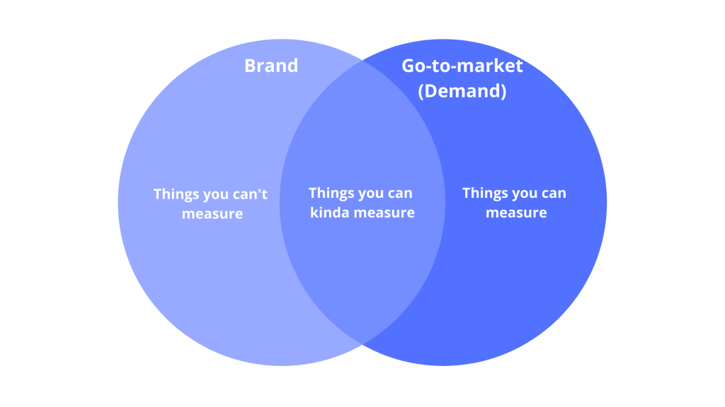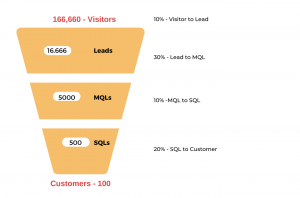In this episode of the GrowthTLDR, we're back with another Swipefile on why marketing should be accountable for revenue.
We discuss how marketing goals are separated into the things you can and can't measure. We cover the most common business models in B2B and the ownership of go-to-market metrics across different teams.
We then get into how marketing can be held accountable for revenue in all these models, and how they can use that to build a forecast model to identify areas to invest in for growth.
All teams with responsibilities for a companies go-to-market need to talk about revenue.
We've talked previously about why all marketing teams should translate their goals into business metrics. Whether it's SEO teams building distribution TAMs, or content marketers measuring their efforts against revenue vs. content metrics - translating your goals into how they generate money for the business is critical.
With marketing, you can think of goals broken across a two circle Venn diagram:

Your marketing investments are split across:
1. Growing your brand - all the investments you need to craft a narrative for your company and to make it stick in your consumers' minds. We talked about how you develop a company narrative with Andy Raskin. Often it's hard to measure the direct impact of these things against revenue. It's hard to develop correlation models so you can determine the loose impact they have on revenue.
But, they're investments you need to make.
Examples would be advertising on podcasts, launching videos across social media platforms, investing in PR, spending time with analysts, etc.
2. Growing your go-to-market - all the investments you make to acquire demand for your product, nurture and engage that demand, and monetize it.
With the right instrumentation of analytics, you can track the direct ROI of these activities, build forecasting models, and prioritize the metrics that matter.
Examples would be customer acquisition (SEO, content marketing, paid advertising), engagement (email nurturing, chat, product onboarding, MQLs, PQLs) monetization (close rates of demand types).
3. The in-between - there are some things you'll do that fall into the middle of these buckets. They both support the brand, and you can develop some correlation models to show how they impact revenue.
For example, if you're a marketing team focused on large enterprise deals, you can run an advertising campaign to target named accounts in specific cities. You can look to see how that advertising campaign impacted revenue vs. the cities where you did nothing. It can't be directly tied to revenue, but you can look at the correlation to revenue.
Another example could be mobile advertising for B2B; consumers will see the ad, but convert on desktop at another time. Advertising on mobile can both grow awareness for your brand, and help to generate revenue through other channels.
So, the above is to acknowledge; some parts of marketing are crucial to a company's success and are hard to measure.
In some companies, marketing could be more heavily weighted towards brand work, vs. go-to-market work, so will be less accountable for revenue, and in other companies, it's flipped.
All go-to-market goals should be revenue-focused.
Common B2B Go-to Markets
In terms of generating *new* revenue, there are three common models for B2B companies (these are not the only models), with responsibilities for metrics across the go-to-market typically being split as follows:
1. The Sales-Led Model
In this model,
- Marketing is accountable for traffic, leads, MQLs
- Sales are responsible for generating revenue from that demand
The % of revenue marketing is accountable for will differ by company.
2. The Product-Led Model
In this model (and it varies a lot by the company)
- Marketing is accountable for traffic and user signups.
- Product is accountable for user activation, monetization of those users.
- Customer success help to expand account revenue
3. Product + Sales (Hybrid)
Many B2B companies combine a low touch self-serve model and pull some of that demand up to their enterprise packages.
In this model (and it varies a lot by the company)
- Marketing is accountable to traffic, users signups, and creating demand for more significant deals
- Product is responsible for user activation, monetization, and surfacing good fit accounts for more significant deals
- Sales are accountable for generating revenue from larger accounts
- Customer success help to expand account revenue
In the above models, marketing should think of their metrics in terms of revenue, and work on a forecasting model to determine how they'll reach their target.
Build a Marketing Plan Based on Revenue
Let's assume you're building a marketing plan for the first model, translating your goals into revenue isn't hard if you've instrumented the analytics correctly.
Your company wants to grow 30% YoY; to do that, they need to generate 100 new customers each month.
You work back up across the funnel, so you now know the amount of MQLs marketing needs to generate each month (and can work back to content leads and traffic).

If each customer is worth $1000, then an MQL is worth $20, and marketing needs to generate $100k of revenue each month. That's the revenue number marketing is accountable too.
Marketing can now build a forecast of how they'll achieve that number. You do this by creating both a top-down model, and bottoms-up model, and identifying your gaps.
- Top-down model: If all metrics remained the same e.g., no conversion rate improvements, the value of a customer remained flat, based on previous X months of growth, how will the next 12 months look - drag the spreadsheet.
- Bottoms-up model: Based on the revenue the company needs to generate each month, how many MQLs, leads, traffic does marketing need to create each month to hit their goals.
You can now look at how significant the gaps are between what you feel marketing will achieve, and what they need to succeed.
You can start to make decisions on where you feel you can make up those gaps:
- Is your biggest opportunity to invest more in SEO to acquire X% more traffic
- Is there an opportunity to improve your traffic to lead conversion rate?
- Maybe your email nurture flows are outdated, and with improvements, you can improve lead to MQL rate
- Or, perhaps you can improve leads to MQL rate by investing in chat.
Remember, it's at this point, real leadership decisions get made. Saying no to things is leadership. Understanding what to invest in is leadership.
And real leadership is being accountable for revenue.
The same accountability and forecasting can work for marketing across all other models.
Listen to the full episode to get all of the details on how you can talk to revenue!
 iTunes
iTunes Stitcher
Stitcher Spotify
Spotify